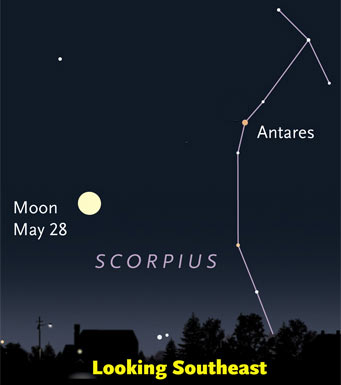
By 11 p.m. on Friday the 28th, the big bright Moon is up in the southeast with Scorpius rising to its right.
Sky & Telescope diagram
Friday, May 28
Saturday, May 29
Sunday, May 30
Monday, May 31
The dim Little Dipper, meanwhile, is now standing almost vertically on its handle-end, Polaris, lower due north.
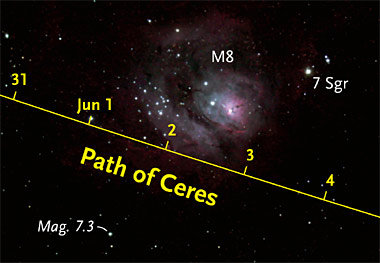
Ceres, magnitude 7.5, is dimly visible in binoculars as it passes south of the Lagoon Nebula in Sagittarius for a few nights in early June 2010. The tick marks are for 0:00 Universal Time (GMT) on the dates indicated; this is at 8 p.m. Eastern Daylight Time on the evening of the previous date.
Sky & Telescope diagram; Everton Allen photo
Tuesday, June 1
For more, and a chart through the end of August, see Ceres in 2010.
Wednesday, June 2
Thursday, June 3
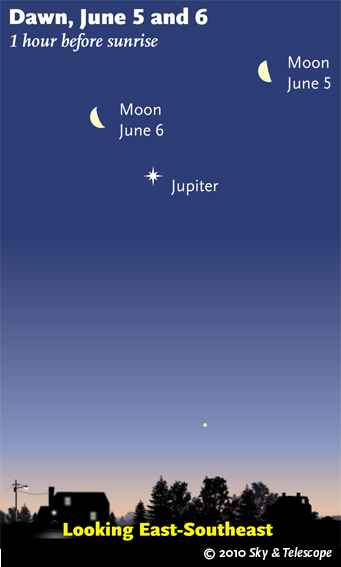
The Moon passing Jupiter in the dawn.
Sky & Telescope diagram
Friday, June 4
Saturday, June 5
Want to become a better amateur astronomer? Learn your way around the constellations. They're the key to locating everything fainter and deeper to hunt with binoculars or a telescope.
For an easy-to-use constellation guide covering the whole evening sky, use the big monthly map in the center of each issue of Sky & Telescope, the essential magazine of astronomy. Or download our free Getting Started in Astronomy booklet (which only has bimonthly maps).
Once you get a telescope, to put it to good use you must have a detailed, large-scale sky atlas (set of charts). The standards are the Pocket Sky Atlas, which shows stars to magnitude 7.6; the larger Sky Atlas 2000.0 (stars to magnitude 8.5); and the even larger and deeper Uranometria 2000.0 (stars to magnitude 9.75). And read how to use your charts effectively.
You'll also want a good deep-sky guidebook, such as Sky Atlas 2000.0 Companion by Strong and Sinnott, or the more detailed and descriptive Night Sky Observer's Guide by Kepple and Sanner or the classic if dated Burnham's Celestial Handbook.
Can a computerized telescope take their place? I don't think so — not for beginners, anyway, and especially not on mounts that are less than top-quality mechanically. As Terence Dickinson and Alan Dyer say in their Backyard Astronomer's Guide, "A full appreciation of the universe cannot come without developing the skills to find things in the sky and understanding how the sky works. This knowledge comes only by spending time under the stars with star maps in hand."
This Week's Planet Roundup
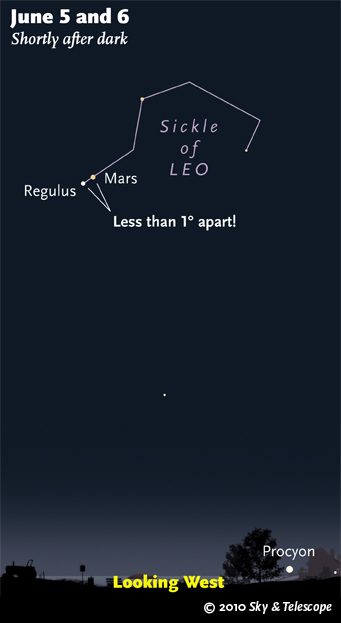
Mars and Regulus in conjunction.
Sky & Telescope diagram
Mercury (about magnitude 0) is having a poor apparition very low in the east at dawn. Scan for it with binoculars far to the lower left of bright Jupiter.
Venus (magnitude –3.9, in Gemini) is the bright Evening Star shining in the west-northwest during and after twilight. Above it are Pollux and Castor. Venus is about as high in twilight as it will get this year (for skywatchers in mid-northern latitudes). Soon it will begin its long summer sink.
In a telescope, Venus is still a small (13-arcsecond) gibbous disk. It's so dazzling, in its brilliant illumination by the Sun, that you'll have the cleanest telescopic views of it in the bright blue sky before sunset — if you can find it then.
Not until late summer will Venus assume its larger and more dramatic crescent phase.
Mars (magnitude +1.1, in Leo) glows high in the west near bluer Regulus (magnitude +1.4) to its left. Mars is closing in on Regulus every day; they pass each other on June 6th, when they'll be 0.8° apart. The star above them or to their upper right is Gamma Leonis.
In a telescope Mars is just a tiny blob, 6.0 arcseconds in diameter. Can you still make out its gibbous phase?
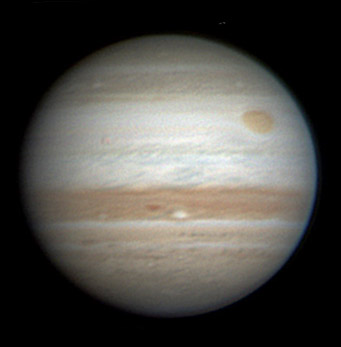
Jupiter's dark North Equatorial Belt is wide and massive, and its South Equatorial Belt is still nearly absent, leaving the Great Red Spot floating free in whiteness. South is up. Christopher Go in the Philippines took this image on May 20th at 20:59 UT, when the central-meridian longitude was 108° (System II). On the central meridian, he writes, "Note the dark and white ovals forming a ying-yang pattern!"
The Great Red Spot is near System II longitude 150°. Assuming it stays there, here's a list to print out of all the Great Red Spot's predicted transit times for the rest of 2010.
Jupiter (magnitude –2.1, below the Circlet of Pisces) shines in the east-southeast in early dawn, climbing higher each week. Nothing else there is nearly so bright! See our article on Jupiter's disappearing South Equatorial Belt.
Saturn (magnitude +1.0, in the head of Virgo) glows high in the southwest during evening. In a telescope Saturn's rings are tilted a mere 1.7° from edge-on, their minimum tilt for the next 15 years. Note the thin black shadow-line that they cast across Saturn's globe.
Uranus (magnitude 5.9, in Pisces) is in the background of Jupiter at the crack of dawn. They close in from 1.3° apart on May 28th to 0.4° at conjunction on June 8th. In a telescope Uranus is only 3.5 arcseconds wide, compared to Jupiter's 38″.
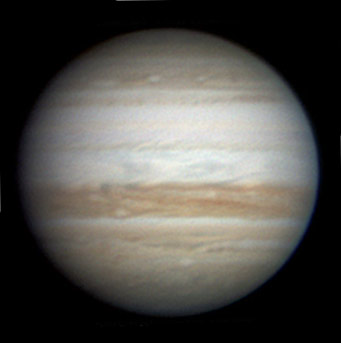
The other side of Jupiter (CM II longitude 343°), imaged by Go on May 24th. South is up. He writes: "The SEB is still very quiet. Note the bluish festoons on the Equatorial Zone extending towards the SEB!"
Neptune (magnitude 7.9, at the Aquarius-Capricornus border) is in view just before dawn well to Jupiter's west (upper right). See our finder charts for Uranus and Neptune in 2010.
Pluto (magnitude 14, in northwestern Sagittarius) is highest in the south in the early morning hours. See our Pluto finder charts for 2010.
All descriptions that relate to your horizon or zenith — including the words up, down, right, and left — are written for the world's mid-northern latitudes. Descriptions that also depend on longitude (mainly Moon positions) are for North America. Eastern Daylight Time (EDT) equals Universal Time (also known as UT, UTC, or GMT) minus 4 hours.
"Rational and innocent entertainment of the highest kind."
— John Mills, 19th century Scottish manufacturer and founder of Mills Observatory, on amateur astronomy.
To be sure to get the current Sky at a Glance, bookmark this URL:
http://SkyandTelescope.com/observing/ataglance?1=1
If pictures fail to load, refresh the page. If they still fail to load, change the 1 at the end of the URL to any other character and try again.
 0
0
Comments
You must be logged in to post a comment.